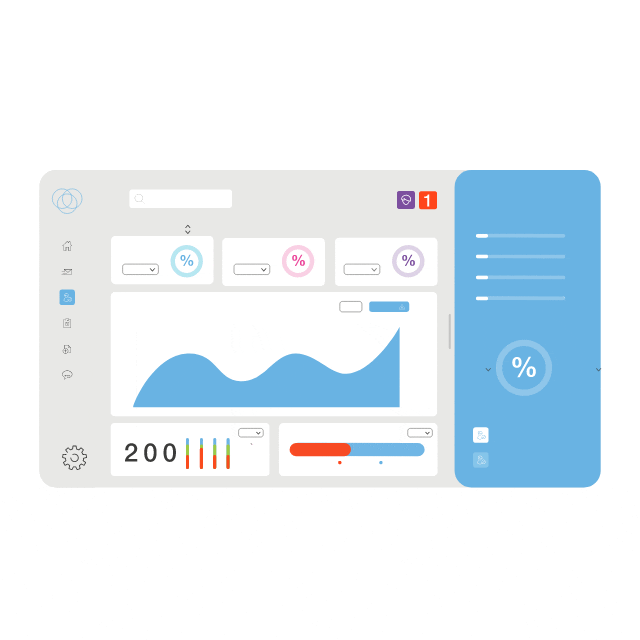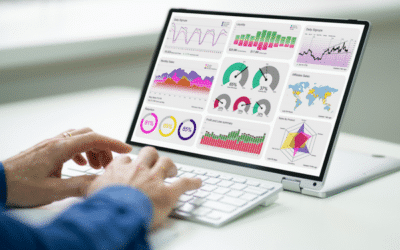Business Intelligence is a concept developed in the 60s. Initially reserved for the largest companies, it has become more widespread over the last two decades. The explosion of corporate data and new technologies makes business intelligence accessible to all.
If you’re not familiar with the concept, we’ll help you understand its ins and outs.
Business Intelligence: definition
Business intelligence is the set of technologies and tools used to collect, analyze and retrieve data. The aim is to enable decision-makers to make the best possible decisions, based on up-to-date, reliable and relevant information.
Numerous software programs and applications now make it possible to simplify this entire process: this is Business Intelligence.

How Business Intelligence works
The information processing chain transforms raw, heterogeneous data into decision-making information. This processing chain follows several phases:
Data collection
This involves the collection of internal company data which, once reprocessed, can be useful to decision-makers. This data can come from any tool or application used in the company (production lines, purchasing, marketing, finance, accounting or IT).
Data integration
All data collected must be recorded in databases, often stored in a data warehouse. This step makes the data available in real time. This data is then cleaned and homogenized to make it usable.
Information retrieval
IT tools can be used to sort all this data, so that it can be presented in the form of reports, dashboards, indicators… which can be easily consulted by decision-makers.
Data analysis
Business Intelligence enables users to easily analyze the results they receive, by looking for correlations (data mining), enabling multi-dimensional analysis (OLAP cubes) or simply presenting them in simple visual form such as graphs.

The importance of Business Intelligence
Business intelligence provides access to accurate, up-to-date information. It can be used to cross-reference data and highlight data correlations. Decision-makers are no longer drowning in a sea of raw data. These are then processed to provide clear and precise dashboards on the various trends and developments observed within the company.
Effective use of BI can therefore optimize an organization’s operations while saving resources.
Some examples of how BI is used :
- Automatic generation of dashboards: these are constantly updated, at no extra cost to the company.
- Automatic calculation of a rate of return
- Search for specific data: sales of product X in a given country, stock trends of product Y over 12 months, seasonality of purchase prices, etc.
- Identify areas for improvement: production lead times, logistical delays, costly procedures, etc.
The benefits of modern Business Intelligence
While reporting, dashboards and KPIs (Key Performance Indicators) are nothing new, Business Intelligence solutions add a new dimension, enabling greater precision and responsiveness:
- Software such as Power Bi(https://powerbi.microsoft.com/fr-fr/), Tableau(https://www.tableau.com/fr-fr) or Qliksens(https://www.qlik.com/fr-fr/) can be used to run queries in real time, providing real-time information without having to use internal resources to produce a new report.
- Calculation algorithms avoid human error, so results are comparable from one period to the next, with no risk of bias in their determination.
- BI is accessible to all levels of the company, enabling everyone to analyze in detail the indicators that concern them, thus enhancing collaborative and participative working.
Modern BI tools are increasingly accessible and intuitive. This means they can be used by as many people as possible, without the need for specialists.
In the medium term, this means significant savings on the resources required to obtain the information needed to run a business.
👆 Want to know more about the best data visualization tools, it’s over here!

The challenges of using BI effectively
A formidable management tool, Business Intelligence needs to be implemented and used correctly to be effective.
Empirically, there are three potential problems that can diminish the benefits of a BI tool:
- Poor quality of input data. These are the basis of BI, and must be correct and complete for optimum results. A great deal of work is required to ensure that the data implemented in information systems is accurate.
- The reluctance of the company’s employees to change. This is all the more true if some workers see BI as a potential threat to their jobs. Nevertheless, communication and training can help convince the majority of employees of the benefits of deploying such solutions.
- Too much unnecessary data, which must be differentiated from incorrect data. This is real information, but its importance to the company is anecdotal, and its quantity may wrongly influence the calculation of the indicators monitored.
Although business intelligence tools are becoming easier and easier to use, it’s still advisable to seek support in order to achieve the desired results.
The Altermès teams, made up of both technical profiles and business experts, are available to help you implement and/or optimize your Business Intelligence project.
👆 Want to know what the best BI and data visualization tools are!
📞You would like to contact us to discuss a topic, a project or a problem!
🔎Find out more about ourinnovative technology solutions for finance departments!











